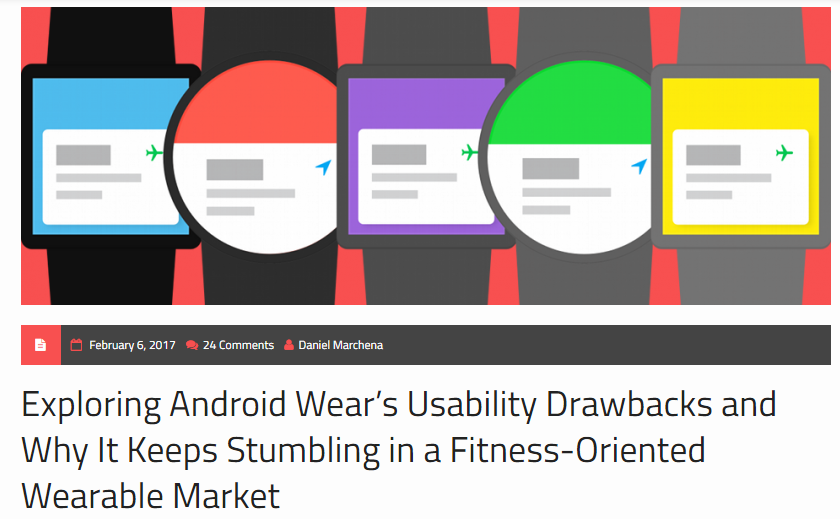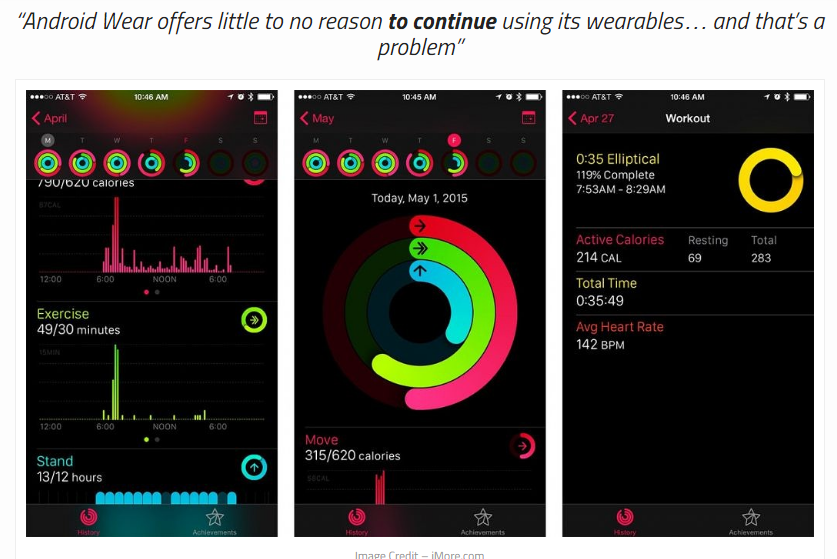“Exploring Android Wear’s Usability Drawbacks and Why It Keeps Stumbling in a Fitness-Oriented Wearable Market,” an article by Daniel Marchena, Co-Host of the XDA/Android Podcast, where he explains some of the drawbacks in the usability of Android’s wearable technology. Wearable technology is a recent trend and the discussions on its usability is relatively new. Mr. Marchena focuses mostly on the Andriod Smart Watch and compares it to other items on the market such as the Apple Watch. In his review he puts a lot of priority on user feedback especially in the areas of notification control and health monitoring.
The article starts by addressing the major draw packs in financial success, or lack of, that the Smart Watch has experiences in comparison to the Apple Watch. The author notes that the success of wearable technology, outside of Fit Bits, is small compared to other areas of technology, such as Phones and Tablets. Mr. Marchena states “Even the Apple Watch had to wait a considerable amount of time – a year and a half – before becoming a “success”; and compared to the iPad and iPhone it really isn’t. Unfortunately, it is difficult to see how the smartwatch economy really shapes up in terms of market share since there are no dedicated or specific Android Wear numbers, but we do know that Apple holds over 50% of the market.” He then goes on to explain the reason people buy wearable technology in the first place noting that the need for notification control, especially in limiting the feedback that user gets from the device, is a factor in owning a wearable device;
• Peer pressure, people buy wearable technology because others buy them.
• Notification control.
• Fitness tracking and health monitoring.
For the first reason, in terms of peer pressure, the Smart Watch does well. It has the ability to accommodate a variety of styles and budgets to fit the needs of the user. If the users wants something sleek and modern Android offers that, if they want something more traditional looking Android offers that to along with a range of prices to fit the budgets of its users. Apple and Samsung on the other hand don’t offer as much in terms of style preference and budget ” If you don’t like square watches, then Apple cannot help you. If you wanted a classy polished watch, then Samsung cannot help you.” For the second reason, and Android does well in this area to. It gives the user enough control, as the author declares, “allowing you to easily reply and dismiss notifications on the fly.” Mr. Marchena acknowledges that although Andriod does well in these two areas it fails because it doesn’t give the user a reason to continue wearing it. “That all comes down to the final reason; while Android Wear offers good and affordable devices to purchase, and offers a great notification experience, it offers little to no reason to continue using its wearables. It wasn’t until the Apple Watch came along that I knew just how bad Android Wear was at offering a compelling reason to continue wearing a watch daily; health and fitness tracking.”
“[Apple] Activity” tracks your active calories, counts your steps, monitors your standing hours and gives you a feedback of your exercise activity, like many other “fitness” applications. It also is always monitoring your heart rate and uses this information to provide timely feedback about how you are doing. All of this information is also seamlessly fed back into a zero impact application, Apple Health, which allows you to see a total overview your healthiness.” This was the overall reason why the Smart Watch wasn’t ranked as highly or considered to do as well as its competitors.
Personally I think user feedback is extremely important especially when it gives the user control over what feedback they receive. However I do not feel that in this case that feedback should considered over the major functionality of the technology. If the Smart Watch is more accessible then it has the ability to reach more people and should be considered a much more obtainable product. In terms of design it seems to have a range of options that can cater to a user’s style. I will note that if a product doesn’t fulfill the major reason why someone has brought it then it is a faulty design, however in this case functionality should be given higher priority. The functionality is not solely based on the health aspects of the Smart Watch because, in my opinion, if someone wanted something to act solely as a Fit Bit they would have brought one. If someone buys a Smart Watch they want it not only for the health tracking aspects but for its other features as well. Although the article is fitness orientated, I will state again that the accessibility of fitness devices should be higher priority. Smart Watch may not be doing as well as the Apple Watch but that can be due to another combination of reasons. I think that although this article gives good information about the area of wearable technologies and gives good reason for why feedback is important it should note that feedback isn’t the only design criteria.
Reference
Marchena, Daniel.(2017). Exploring Android Wear’s Usability Drawbacks and Why It
Keeps Stumbling in a Fitness-Oriented Wearable Market.Xda-developer. Retrieved from https://www.xda-developers.com/exploring-android-wear-its-massive-usability-problem-and-why-it-keeps-failing/

